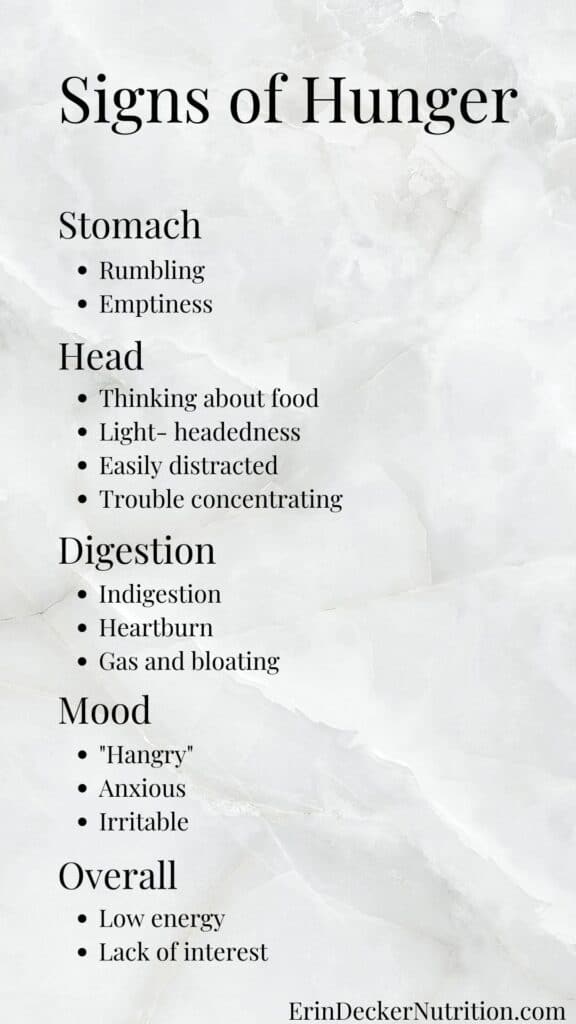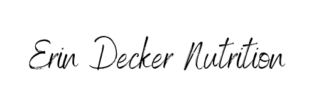Most of the time I am counseling my clients to eat more food. They have been eating low calorie diets for months, if not years, and they are feeling burnt out, exhausted, and their health is declining.
But, introducing more calories often comes with some resistance – “I just don’t feel hungry!”
Many times, there is a disconnect in what hunger feels like. There are also reasons why you might not feel hungry in the first place, especially if you have been dieting.
How hunger is regulated
Before diving into what hunger feels like, let me describe how hunger is regulated in the first place.
Hunger and fullness are both regulated by a cascade of hormones and neurotransmitters.
Ghrelin is your main hunger hormone, produced in your stomach. Levels rise prior to a meal and fall as you start eating. The presence of ghrelin triggers the release of neuropeptide Y, a powerful appetite stimulant that communicates to your brain that it is time to start eating.
Leptin is your main fullness hormone, rising as you begin eating. It is produced in your fat cells in direct proportion to the amount of fat stored. This is thought to be a key player in the set point theory, as levels increase with weight loss and decrease with weight gain.
Peptide YY is another fullness hormone produced in the small intestine. This travels to your brain and binds with receptors to tell your brain that you are full. The response is highest following a high protein and fat meal.
Lastly, glucagon-like-peptide-1 (GLP-1) is a hormone that plays a role in regulating stomach emptying. For example, the more GLP-1 you have, the slower your stomach empties, leading you to feel full for longer. Some people have a reduced response of GLP-1, such as those with type 2 diabetes.
These hormones can be affected by sleep quality, stress levels, physical activity, diet composition, body composition and genetics.
Should you only eat when hungry?
A common approach to dieting involves eating when you’re hungry and stopping when you’re full. However, there are times you may still need to eat, even if you don’t feel hungry.
For example, your body can turn off hunger cues and slow down digestion when calories are restricted. This allows more time for nutrient absorption during periods of starvation. In addition, with less food going in, there is simply less need to support faster and ongoing digestion.
Bottom line: if you have been restricting calories, your hunger cues cannot be trusted.

In addition, some people don’t feel classic hunger symptoms such as the rumbling in the stomach. This is especially true if you tend to be distracted by work or caretaking during the day.
What are some signs of hunger?
Hunger symptoms can present differently for everyone. While most are familiar with the stomach rumbling, there are other symptoms that you may not think about. See below for some common signs.
| Stomach | Head | Digestion | Mood | Overall |
| Rumbling Emptiness | Thinking about food Light- headedness Easily distracted Trouble concentrating | Indigestion Heartburn Gas and bloating | “Hangry” Anxious Irritable | Low energy Lack of interest |
So yes: eating when you are hungry is a great strategy if your hunger cues are working properly and you know the signs of hunger for yourself. But if they are not working properly or you’re not familiar with the more subtle signs, it can easily lead you astray.

What if you’re still hungry after eating?
When you are getting comfortable with intuitive eating and honoring hunger cues, it is common to still feel hungry after eating what you used to consider a full meal.
If you have a history of restricting, you could be experiencing symptoms of extreme hunger.
However, it’s possible you are just getting better at tuning into what your body needs! If this is the case for you, take a few more bites and check back in with yourself. Does it make a difference?
You could also look at the composition of your meal. The most filling meals contain a combination of all three macronutrients: carbohydrate, protein, and fat. As described above, protein and fat have the biggest impact on the fullness hormone peptide YY. Carbohydrates also provide your body with fiber, which can slow down digestion and keep you full for longer.

How to Reconnect with Hunger Cues
There are a few techniques you can use to start reconnecting with your hunger cues.
Use an intuitive eating hunger scale
A hunger scale is used to determine how hungry or full you are on a scale of 1 to 10. In general, 1 is absolutely empty, and 10 is stuffed full. There is no exact definition for what each level feels like, and you should use your own judgment to figure out what works best for you.
Keep in mind: the goal is not to avoid the extremes at the beginning! It is simply to become aware of what these different levels feel like. It is impossible to find the middle ground if you don’t know what the extremes feel like.
Track in an intuitive eating journal
Food journaling can be a powerful tool. However, use caution if you have a history of disordered eating or find journaling your food to be triggering for you.
That being said, making note of what you eat, when you eat it, and any thoughts or feelings you have around the food can be helpful to identify your reasons for eating and bring awareness to any diet thoughts you may have.
There are some apps out there you can experiment with, or just use a paper journal or a notes app on your phone.
Recommended intuitive eating apps
See below for some of my favorite apps to use when you are moving toward intuitive eating and reconnecting with hunger cues:
- Rise up and Recover – This free app is a food journaling app developed for eating disorder recovery. It lets you track what you ate, when you ate it, any thoughts and feelings about the food, and if you engaged in any disordered eating behaviors such as restriction or purging.
- Recovery Record – Similar to Rise up and Recover, this app allows you to keep track of food and emotions, in addition to uploading photos of your meals. If you are working with a dietitian, they can also see your journal and leave comments. This is free for the client, and the provider pays a fee.
- Peace with Food – This free app allows you to check-in before meals and several times throughout the day to see what level “hungry” you are. It then has a timer for meal times with encouraging, mindful eating reminders. It allows space to leave notes about how you are feeling.
- Am I Hungry? – This affordable app provides a decision tree for determining whether you are hungry and offers mindfulness cues to help tune into your body.
- Basic “Notes” app – The one that comes pre-downloaded on your phone! These apps are just like freehand journaling, but accessible from your smartphone.
Work with an intuitive eating dietitian
Figuring out what hunger feels like and reconnecting with your hunger cues can take time. Working with a professional can help make sure that you are getting the proper nutrition you need, which can ensure that your hunger cues are working properly in the first place.

Generally speaking, one knows the symptoms of hunger when they arise. However, this is a good piece that goes in-depth into hunger, what it entails, and what can be done in response.